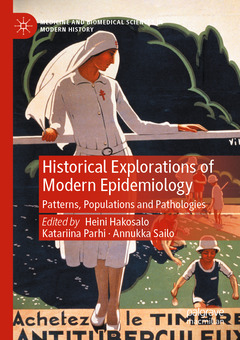Historical Explorations of Modern Epidemiology, 2023 Patterns, Populations and Pathologies Medicine and Biomedical Sciences in Modern History Series
Coordonnateurs : Hakosalo Heini, Parhi Katariina, Sailo Annukka

Chapter 1: Introduction: The Past Continuous of Epidemiology.- Part I: Patterns.- Chapter 2: Patterning Tuberculosis: Interwar Tuberculosis Research as a Bridge between Infectious and Risk Factor Epidemiology.- Chapter 3: Nicolas Brault. The Case-Control Method on Trial: The “Bermuda Summit Peace Conference” (1978).- Chapter 4: The Coexistent Temporalities: Multilayered Ethics in Birth Cohort Studies.- Part II: Populations.- Chapter 5: The Oxford Nutrition Survey (1941–50): Its Rise and Fall under Hugh Sinclair.- Chapter 6: Spotlighted or Hidden in Plain Sight: Consequences of the Post-War Ban on Ethnic Registration in Sweden.- Chapter 7: Risk Factor Epidemiology Viewed from Below: Lay Reception of the North Karelia Project (Finland) in the 1970s and early 1980s.- Chapter 8: From Colonial Medicine to Global Health: Epidemiologies of Sexually Transmitted Diseases in in East and Central Africa.- Part III: Pathologies.- Chapter 9: Light Pollution: Auroral Displays, Environmental Carcinogens and Epidemiological Imaginings of Inuit Cancer.- Chapter 10: Scientized Politics: Finnish Basic Income Trial as a Quest for Experimental Truth.- Chapter 11: Virus-Imagery: A Short History of Pandemic Mis-Representation, HIV to COVID-19.
Heini Hakosalo is a Senior Research Fellow in the History of Sciences and Ideas at the University of Oulu, Finland. She specializes in the history of medicine and health and has published on the histories of brain sciences, medical education, tuberculosis, birth cohort studies, and the relationship between urban planning and epidemics. She is the co-editor of In Pursuit of Healthy Environments: Lessons from Historical Cases on the Environment-Health Nexus (2021).
Katariina Parhi works as a Post-doctoral Researcher at the Academy of Finland Centre of Excellence in the History of Experiences at Tampere University, Finland. Her publications deal with the history of psychiatry, social control, and cohort studies, and include two Finnish-language books on the history of psychopathy and history of drug treatment systems, respectively.
Annukka Sailo is a Post-doctoral Researcher in the History of Sciences and Ideas at the University of Oulu,Finland. She has studied the history of post-war social and behavioral sciences, focusing on US debates on territorial aggression, and is currently researching the connection between urban planning and epidemiology in history.
Date de parution : 04-2024
Ouvrage de 270 p.
14.8x21 cm
Date de parution : 04-2023
Ouvrage de 270 p.
14.8x21 cm
Thèmes de Historical Explorations of Modern Epidemiology :
Mots-clés :
Epide; Epidemiological knowledge production; Epidemiological research; Cohort studies; Indigenous epidemiology; Post-war history; Reproductive health; History of disease; Epidemiological methodology; Lay epidemiology; Colonial medicine; Global epidemiology; Cancer; HIV; Ethnicity; Health policy; Pandemic; Public health; Covid-19; Epidemiological modelling



